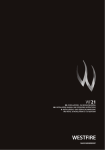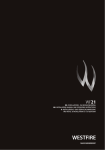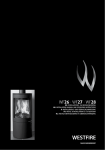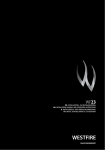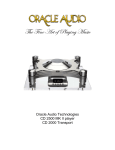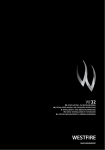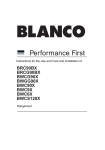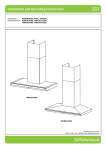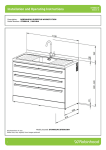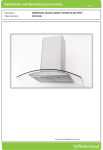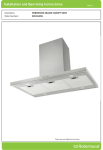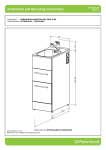Download WF21 - Wood Burning Stoves
Transcript
WESTFIRE · WF21 WF21 DK: INSTALLATIONS- OG BRUGSVEJLEDNING UK: INSTALLATION MANUAL AND OPERATING INSTRUCTIONS D: INSTALLATIONS- UND GEBRAUCHSANWEISUNG FR: NOTICE D’INSTALLATION ET D’UTILISATION 1 dansk ingeniørkunst UK WESTFIRE · WF21 UK: INSTALLATION MANUAL AND OPERATING INSTRUCTIONS – WESTFIRE WF21 This manual refers to the stove type listed below, which has been tested in accordance with EN 13240. Congratulations on your purchase of a new wood burning stove from Westfire ApS. Please read this manual carefully in order to ensure that you get maximum enjoyment from your new stove and to prevent any problems. Please note that “all local regulations, including those referring to national and European Standards, need to be complied with when installing this appliance”. For further information on installing and using fireplaces and wood burning stoves, please see the relevant brochure on building regulations that applies to the country in which WF 21 has been approved, as well as the relevant brochure on the correct use of wood burning stoves available from your local stove supplier or your chimney sweep. INSTALLATION GUIDELINES You must comply with all applicable national and local building regulations when installing your wood burning stove. Please see the applicable regulations for full details. The regulations state that flammable floors beneath closed hearths must be covered by a fire-proof material that extends a minimum of 30 cm in front of the stove opening and a minimum of 15 cm on either side. The fire-proof material may be e.g. a steel plate, a glass plate, tiles or artificial slate. The floor on which the wood burning stove is to be installed must be sufficiently strong to carry the weight of the stove. The minimum distances to flammable materials are specified on the EN 13240 plaque on the back of the stove. WF 21 Rear (cm) Sides (cm) Furniture in front (cm) 17,5 cm 30 cm 80 cm There are no rules regarding the minimum distance to non-flammable walls, but we recommend leaving a gap of at least 10 cm behind the stove to make cleaning easier. Combustion requires air, and fresh air must therefore be available in the room in which the stove is installed. Air inlets must be positioned in such a way that they cannot be blocked. An air inlet may be a vent (the vent must be open and the capacity of the vent sufficient when the stove is lit) or a fresh air system linked to the stove. All wood burning stoves from Westfire are fitted with heat deflection baffles, which ensure the maximum efficiency and the clean burn of the stove. These baffles should not be removed. CHIMNEY CONNECTION The chimney to which the stove is connected must have a diameter of at least 15 cm, which corresponds to an area of 175 cm2. The chimney must be sufficiently long to provide a good chimney draft, and to ensure that the smoke from the stove will not cause a nuisance. The chimney must be fitted with an easily accessible cleaning hatch. WF 21 has been approved in accordance with EN 13240. The nominal heat output of this stove is 5 kW. WF 21 has a test weight of 81 kg. Minimum draft: The stove has been tested with a draft of 12 Pa. Max. draft 25 Pa. Flue gas flow 6.3 g/sec. Flue gas temperature 248°C. WF 21 is fitted with both a top and rear outlet. The chimney may be equipped with a regulation damper in the flue pipe to allow the draft to be regulated on windy days. The damper must not be able to close fully, and must have a clearance of at least 20 cm2 of the total clear opening of the pipe. 6 UK WESTFIRE · WF21 Other types of dampers may also be used, such as allowing air to enter the chimney by bypassing the stove. More than 1 appliance on a flue system is not allowed in the UK under any circumstance. Operating instructions The heat-resistant paint on the stove will harden the first time you light up the appliance. This process produces a good deal of smoke and odour, and the room should therefore be well ventilated. The stove door should be kept open during the first couple of firings and only closed once the stove has cooled down to prevent the packing cord around the door from sticking and coming away from the door. Once the heat-resistant paint has hardened, the stove door must be kept closed except when lighting the stove, adding firewood or removing ash in order to prevent flue gas from escaping. Firelighters should ideally used when lighting the stove. (Never use mentholated spirit, petrol or other flammable liquids) To light the stove 1.Place a few smaller pieces of dry wood (kindling) in the stove on top of the non toxic firelighters. 2.Fully pull open the air slider(secondary air) 3.Light the firelighters and push the door closed until it is 1-2cm open. (do not lock the door shut) 4.Once the fire has caught, add two pieces of wood measuring approx 20cm with a combined weight of approx 1.2kg and again push the door closed until it is 1-2cm open. (do not lock the door shut) 5.After approximately 5 minutes when the fire is burning brightly shut the door. (leave air slider fully open) 6.After approximately another 7 minutes close the air slider by 10% (90% open) At nominal heat output, expect to refuel your stove approximately once an hour. WF 21 is designed for intermittent combustion (wood must be added often and the stove is not designed for 24-hour use). WF 21 is equipped with a control valve for secondary air designed to ensure a plentiful supply of oxygen during firing. When lit, the stove will get very hot and due care must therefore be exercised. Please use a glove when operating levers and dampers. In the event of a chimney fire: Close the air damper and the stove door, and call 999 or your local fire department. BASIC POSITIONS OF DAMPERS DURING OPERATION Secondary air WF 21 90 % open You will need to become familiar with your stove in order to be able to regulate the secondary air intake correctly, as factors such as the quality and height of your chimney, the quality of your fuel and the external conditions play a large role. It is easy to see whether the stove is functioning correctly, however. Incomplete combustion may lead to a build-up of hard, shiny soot on the inside of your stove. This is prevented by the introduction of additional secondary air. It is important to check the draft conditions before lighting your stove. This may be done, for instance, by crumpling a piece of newspaper, placing it in the combustion chamber and lighting it. The draft conditions are good if the smoke is drawn away through the chimney. FUEL Never use toxic wood such as chipboard, impregnated or painted wood. Always use dry firewood. The dryness of the firewood plays an important role since the use of wet wood results in poor fuel economy and may cause tarry soot to form. 7 UK WESTFIRE · WF21 Newly cut wood contains 60–70% water, making it totally unsuitable for use as firewood. Newly cut wood should be stacked and air dried under cover for two years before being used as firewood. MAINTENANCE Ash must be removed from the stove at regular intervals. The stove must be completely cold before being cleaned. The outside should be cleaned using a dry cloth. The inside of the stove should be cleaned once a year. To clean the inside, remove all ash, soot and tar residue from the combustion chamber. The smoke plate should be removed as dirt and soot will collect behind it. The packing cord in the door will wear over time and should therefore be checked. The stove, the flue pipe connection and the chimney should be checked regularly by a qualified engineer. The chimney should also be checked for blockages before relighting the stove if it has not been used for an extended period of time. The lacquer may wear thin in exposed places due to overheating. This, and other lacquer damage, may be repaired using a special senotherm lacquer spray available at all stove outlets. Ash must be stored in a non-combustible container and must not be mixed with other combustible waste. The combustion chamber is lined with Skamol. These panels will wear over time and will therefore need replacing. The same is true for the smoke plate. A Skamol panel may crack if hit too hard by a piece of firewood. This has no effect on the function of the stove (this is not the case with the smoke plate). The Skamol panels will only need to be replaced once they become very worn and are no longer whole, or if they crack in several places. The air damper and the stove door must be closed in the event of overheating. OPERATING PROBLEMS Soot forms on the window: The firewood may be too wet, or the intake of secondary air may be insufficient. The wood burns too quickly: The chimney draft may be too strong, or there may be a leak near the door of the stove. The stove fails to heat fully: The firewood may be too wet. Smoke or odour: Weak chimney draft – check for blockages in the flue pipe/chimney and check the height of the chimney in relation to the surroundings. Soot in the chimney: The firewood may be too wet, or the intake of secondary air may be insufficient. GUARANTEE Your new stove is covered by a five year guarantee against manufacturing defects. Your receipt documents the date of purchase. The guarantee does not cover damage caused by faulty operation such as overheating or the stove being incorrectly connected, or damage which occurs as a result of external physical force. The guarantee does not cover damage to replaceable parts, transport costs associated with repairs under warranty or the installation/dismantling of the stove in connection with repairs under warranty. Warning! Any unauthorised modification of the appliance is forbidden. Only replacement parts recommended by Westfire ApS should be used for repairs. 8 UK WESTFIRE · WF21 VERMICULITE FIRE BRICK INSTALLATION SEQUENCE – WESTFIRE UNIQ 21 Installation procedure: Right inner top baffle brick 2 – positioned on secondary air pipe & side supports. 1 – Left Inner Top Baffle Brick 2 – Right Inner Top Baffle Brick 3 – Rear Brick 4 – Left Base Brick 5 – Right Base Brick 6 – Left Angled Side Brick 7 – Right Angled Side Brick 8 – Left Side Brick 9 – Right Side Brick 10 – Top Baffle Brick 1. 2. 10. 3. 6. 8. 7. 4. 5. 9. Left inner top baffle bricks 1 positioned on secondary air pipe & side supports. Left and right angled side bricks 6 & 7 fitted. Right inner top baffle brick 2 – positioned on secondary air pipe & side supports. Left and right angled side bricks 6 & 7 fitted. Top baffle bricks 2 & 3 fitted. Left and right side bricks 8 & 9 fitted. Rear brick 3 – line up tertiary air holes. Front face of brick has smaller surface area. Left and right side bricks 8 & 9 fitted. Left & right base bricks 4 & 5 fitted – with metal base brick tensioner positioned at side. Top baffle brick 10 (smallest straight edge resting on top edge of rear brick) fitted and supported with two side pins. 9 UK WESTFIRE · WF21 UK: INSTALLATION MANUAL AND OPERATING INSTRUCTIONS WESTFIRE WF UNIQ21 · WF UNIQ21 WALL HUNG · WF UNIQ21 PEDESTAL This manual refers to the stove type listed above, which has been tested in accordance with EN 13240. Congratulations on your purchase of a new wood burning stove from Westfire ApS. Please read this manual carefully in order to ensure that you get maximum enjoyment from your new stove and to prevent any problems. Please note that “all local regulations, including those referring to national and European Standards, need to be complied with when installing this appliance”. For further information on installing and using fireplaces and wood burning stoves, please see the relevant building regulations that apply to the country in which UNIQ 21 has been approved, as well as the relevant documents on the correct use of wood burning stoves available from your local stove supplier or your Chimney sweep. These instructions cover the basic principles to ensure the satisfactory installation of the UNIQ 21 wood stove, although detail may need slight modification to suit particular local site conditions. In all cases the installation must comply with current Building Regulations, Local Authority Byelaws and other specifications or regulations as they affect the installation of the stove. It should be noted that the Building Regulations requirements may be met by adopting the relevant recommendations given in British Standards BS 8303, BS 6461 and BS 7566 as an alternative means to achieve an equivalent level of performance to that obtained following the guidance given in Approved Document J. HEALTH AND SAFETY PRECAUTIONS Special care must be taken when installing the stove such that the requirements of the Health and Safety at Work Act are met. Handling Adequate facilities must be available for loading, unloading and site handling. Fire Cement Some types of fire cement are caustic and should not be allowed to come into contact with the skin. In case of contact, wash immediately with plenty of water. Asbestos This stove contains no asbestos. If there is a possibility of disturbing any asbestos in the course of installation then please seek specialist guidance and use appropriate protective equipment. Metal Parts When installing or servicing this stove care should be taken to avoid the possibility of personal injury. WESTFIRE UNIQ 21 WOODSTOVE UNIQ 21 dimensions WF UNIQ 21 WF UNIQ 21 WALL HUNG WF UNIQ 21 PEDESTAL Height 800 mm 730 mm 1140mm Width 440mm 440mm 440mm Depth 430mm 450mm ( inc bracket) 430mm Closed combustion option YES YES YES 10 UK WESTFIRE · WF21 STOVE PERFORMANCE & TESTING Westfire WF UNIQ 21 has been approved in accordance with EN 13240. Stove model Weight Nominal heat output WF UNIQ 21 PEDESTAL WF UNIQ 21 81KG wood Smokeless fuels YES N/A WF UNIQ 21 WALL HUNG WF UNIQ 21 PEDESTAL 81KG YES N/A 91KG YES N/A PREPARATORY WORK AND SAFETY CHECKS IMPORTANT WARNING This stove must not be installed into a chimney that serves any other heating appliance. There must not be an extractor fan fitted in the same room as the stove as this can cause the stove to emit fumes into the room. CHIMNEY Chimney Connection Flue Diameter 150mm (175cm2) IMPORTANT: When installing the WF UNIQ 21 wood stove remove steel retaining bar across top flue exit. Remove bolts and take out bar replace and bolt cast onto collar. In order for the stove to perform satisfactorily the chimney height must be sufficient to ensure an adequate draught so as to clear the products of combustion and prevent smoke problems into the room. Minimum draft: WF UNIQ 21 stove has been tested with a draft of 12 Pa. Maximum draft 25 Pa. Flue gas flow 4.2 g/sec. Flue gas temperature 240°C. approximately 12 Pa. NOTE: A chimney height of not less than 4.5 metres measured vertically from the outlet of the stove to the top of the chimney should be satisfactory. Alternatively the calculation procedure given in BS 5854:1980 may be used as the basis for deciding whether a particular chimney design will provide sufficient draught. The outlet from the chimney should be above the roof of the building in accordance with the provisions of Building Regulations Approved Document J. If installation is into an existing chimney then it must be sound and have no cracks or other faults which might allow fumes into the house. Older properties, especially, may have chimney faults or the cross section may be too large i.e. more than 160 mm x 160 mm. Remedial action should be taken, if required, seeking expert advice, if necessary. If it is found necessary to line the chimney then a flue liner suitable for solid fuel must be used in accordance with Building Regulations Approved Document J. Any existing chimney must be clear of obstruction and have been swept clean immediately before installation of the stove. If the stove is fitted in place of an open fire then the chimney should be swept one month after installation to clear any soot falls which may have occurred due to the difference in combustion between the stove and the open fire. If there is no existing chimney then either a prefabricated block chimney in accordance with Building Regulations Approved Document J or a twin walled insulated stainless steel flue to BS 4543 can be used. These chimneys must be fitted in accordance with the manufacturer’s instructions and Building Regulations. 11 14136 Mediegruppen Reklamebureau Der tages forbehold for trykfejl WESTFIRE 2009 24 Tømrervej 3 | DK-6800 Varde | telefon +45 7522 5352 | fax +45 7522 1352 | www.westfire.dk | e-mail: [email protected]








